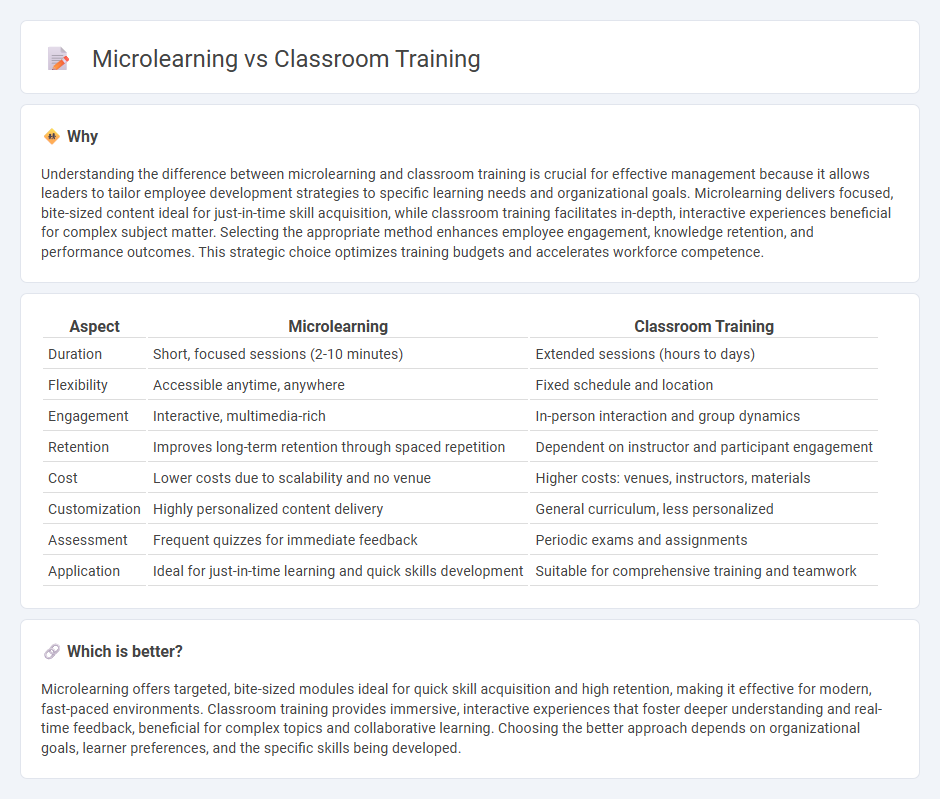
Microlearning offers concise, focused training modules that enhance knowledge retention and flexibility compared to traditional classroom training. Classroom training provides immersive, interactive experiences that foster direct communication and team collaboration. Explore how these approaches can optimize your organization's management development strategy.
Why it is important
Understanding the difference between microlearning and classroom training is crucial for effective management because it allows leaders to tailor employee development strategies to specific learning needs and organizational goals. Microlearning delivers focused, bite-sized content ideal for just-in-time skill acquisition, while classroom training facilitates in-depth, interactive experiences beneficial for complex subject matter. Selecting the appropriate method enhances employee engagement, knowledge retention, and performance outcomes. This strategic choice optimizes training budgets and accelerates workforce competence.
Comparison Table
| Aspect | Microlearning | Classroom Training |
|---|---|---|
| Duration | Short, focused sessions (2-10 minutes) | Extended sessions (hours to days) |
| Flexibility | Accessible anytime, anywhere | Fixed schedule and location |
| Engagement | Interactive, multimedia-rich | In-person interaction and group dynamics |
| Retention | Improves long-term retention through spaced repetition | Dependent on instructor and participant engagement |
| Cost | Lower costs due to scalability and no venue | Higher costs: venues, instructors, materials |
| Customization | Highly personalized content delivery | General curriculum, less personalized |
| Assessment | Frequent quizzes for immediate feedback | Periodic exams and assignments |
| Application | Ideal for just-in-time learning and quick skills development | Suitable for comprehensive training and teamwork |
Which is better?
Microlearning offers targeted, bite-sized modules ideal for quick skill acquisition and high retention, making it effective for modern, fast-paced environments. Classroom training provides immersive, interactive experiences that foster deeper understanding and real-time feedback, beneficial for complex topics and collaborative learning. Choosing the better approach depends on organizational goals, learner preferences, and the specific skills being developed.
Connection
Microlearning complements classroom training by delivering focused, bite-sized content that reinforces key concepts introduced during in-person sessions. This blended approach enhances knowledge retention and engagement by allowing learners to revisit materials at their own pace while benefiting from direct instructor interaction. Integrating technology-driven microlearning modules with traditional classroom exercises creates a dynamic and flexible learning environment tailored to diverse management training needs.
Key Terms
Duration
Classroom training sessions typically last several hours to full days, offering in-depth exploration of topics but demanding significant time commitment. Microlearning breaks content into brief, focused segments ranging from 2 to 10 minutes, enhancing retention and fitting easily into busy schedules. Explore how adopting microlearning can optimize your training efficiency and learner engagement.
Delivery Method
Classroom training relies on in-person instruction, promoting direct interaction and immediate feedback through structured schedules. Microlearning delivers content in bite-sized, on-demand modules accessible via digital platforms, enhancing flexibility and retention. Explore more to understand which delivery method suits your learning goals best.
Content Depth
Classroom training offers comprehensive content depth, allowing for detailed explanations and hands-on practice that cater to complex subject matter. Microlearning delivers concise, targeted information designed for quick comprehension and immediate application, ideal for reinforcing specific skills or concepts. Discover how balancing these approaches can optimize learning effectiveness by exploring their distinct content delivery benefits.
Source and External Links
Classroom-Based Training - This traditional training method involves an instructor delivering content in a physical classroom setting, allowing for direct interaction and personalized guidance.
Benefits of Classroom-Based Training - Highlights the unique benefits of classroom-based training in delivering interactive learning experiences and its higher return on investment compared to online training.
Classroom Training Courses - Offers a variety of in-person courses across industries to enhance skills through group learning and networking opportunities.
 dowidth.com
dowidth.com